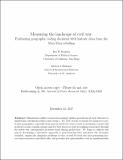Files in this item
Measuring the landscape of civil war : evaluating geographic coding decisions with historic data from the Mau Mau rebellion
Item metadata
| dc.contributor.author | Douglass, Rex W. | |
| dc.contributor.author | Harkness, Kristen A. | |
| dc.date.accessioned | 2018-02-16T10:30:07Z | |
| dc.date.available | 2018-02-16T10:30:07Z | |
| dc.date.issued | 2018-03-01 | |
| dc.identifier | 251779473 | |
| dc.identifier | 395f4fa3-7ed2-4763-9c90-4a867b56d27a | |
| dc.identifier | 85044084156 | |
| dc.identifier | 000429881300005 | |
| dc.identifier.citation | Douglass , R W & Harkness , K A 2018 , ' Measuring the landscape of civil war : evaluating geographic coding decisions with historic data from the Mau Mau rebellion ' , Journal of Peace Research , vol. 55 , no. 2 , pp. 190-205 . https://doi.org/10.1177/0022343318754959 | en |
| dc.identifier.issn | 0022-3433 | |
| dc.identifier.other | ORCID: /0000-0001-5882-3745/work/60427624 | |
| dc.identifier.uri | https://hdl.handle.net/10023/12735 | |
| dc.description | This research has been supported by grants from the Air Force Office of Scientific Research (FA9550-09-1-0314) and the Department of Defense Minerva Initiative through the Office of Naval Research (N00014-14-0071). | en |
| dc.description.abstract | Subnational conflict research increasingly utilizes georeferenced event datasets to understand contentious politics and violence. Yet, how exactly locations are mapped to particular geographies, especially from unstructured text sources such as newspaper reports and archival records, remains opaque and few best practices exist for guiding researchers through the subtle but consequential decisions made during geolocation. We begin to address this gap by developing a systematic approach to georeferencing that articulates the strategies available, empirically diagnoses problems of bias created by both the data-generating process and researcher-controlled tasks, and provides new generalizable tools for simultaneously optimizing both the recovery and accuracy of coordinates. We then empirically evaluate our process and tools against new microlevel data on the Mau Mau Rebellion (Colonial Kenya 1952-1960), drawn from 20,000 pages of recently declassified British military intelligence reports. By leveraging a subset of this data that includes map codes alongside natural language location descriptions, we demonstrate how inappropriately georeferencing data can have important downstream consequences in terms of systematically biasing coefficients or altering statistical significance and how our tools can help alleviate these problems. | |
| dc.format.extent | 16 | |
| dc.format.extent | 1854890 | |
| dc.language.iso | eng | |
| dc.relation.ispartof | Journal of Peace Research | en |
| dc.subject | Archival data | en |
| dc.subject | Armed conflict | en |
| dc.subject | Event data | en |
| dc.subject | Georeferencing | en |
| dc.subject | Kenya | en |
| dc.subject | Mau Mau | en |
| dc.subject | JZ International relations | en |
| dc.subject | DT Africa | en |
| dc.subject | DAS | en |
| dc.subject | BDC | en |
| dc.subject | SDG 16 - Peace, Justice and Strong Institutions | en |
| dc.subject.lcc | JZ | en |
| dc.subject.lcc | DT | en |
| dc.title | Measuring the landscape of civil war : evaluating geographic coding decisions with historic data from the Mau Mau rebellion | en |
| dc.type | Journal article | en |
| dc.contributor.institution | University of St Andrews. School of International Relations | en |
| dc.identifier.doi | 10.1177/0022343318754959 | |
| dc.description.status | Peer reviewed | en |
| dc.date.embargoedUntil | 2018-02-15 |
This item appears in the following Collection(s)
Items in the St Andrews Research Repository are protected by copyright, with all rights reserved, unless otherwise indicated.

